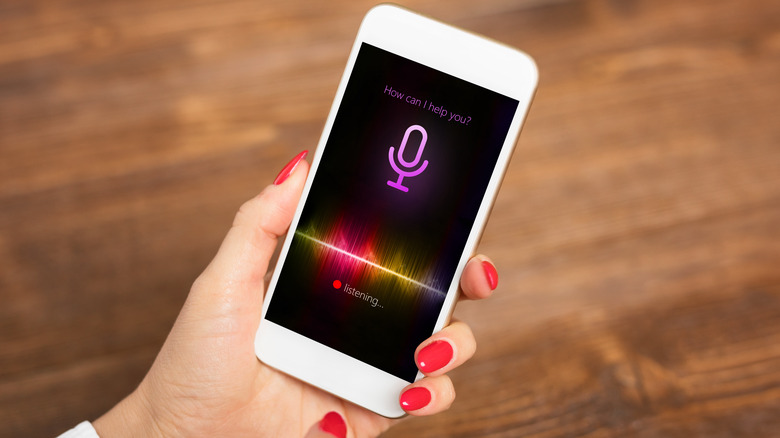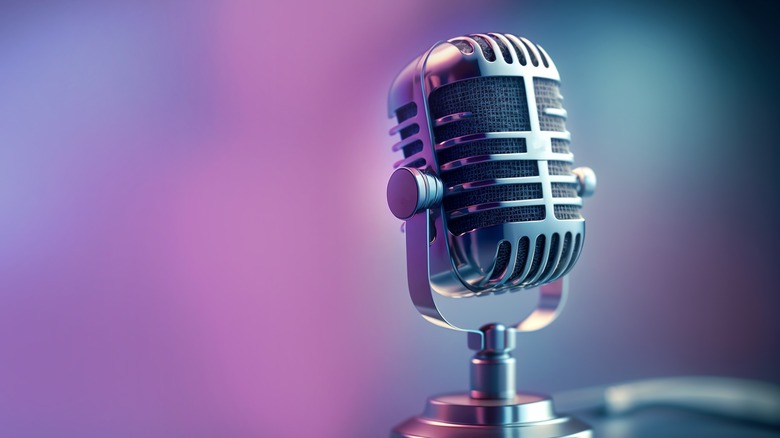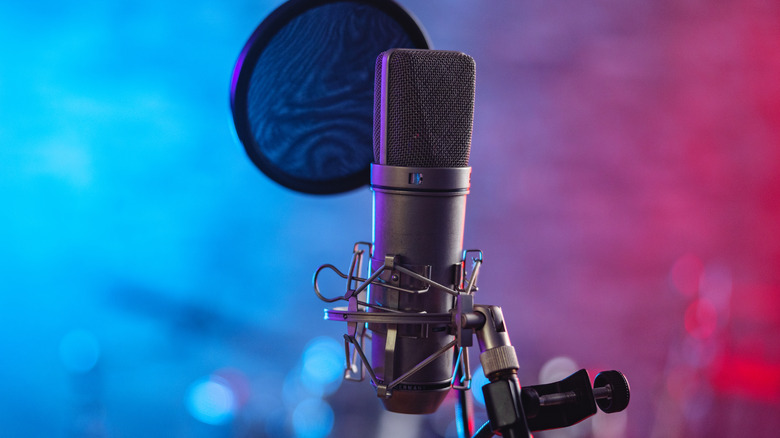How To Connect A Wireless Microphone To Your iPhone
Cell phones have come a long way since their introduction in the 1980s. Long gone are cumbersome, antennaed devices, and though there are still plenty of affordable and practical flip phones out there, they've become far less common than they were previously. Nowadays, phones can do it all, from contacting friends and family in a variety of ways to surfing the Internet, accessing virtually all social media platforms, playing games, and more. Despite these innovations, though, even top-of-the-line models like Apple's ever-popular iPhone can be enhanced with additional hardware, such as external microphones.
iPhones have changed the game in the realm of mobile communication, and they've improved in more ways than one. Cameras have gotten more crisp and vibrant, accessibility options have expanded, and microphone quality has gone up. Still, whether you're a reporter conducting an on-the-fly interview, an aspiring voice actor with a limited equipment budget, or just someone who likes to experiment with the latest in audio recording technology, investing in an external microphone could be worthwhile to you.
Thankfully, it's not hard to connect one of the many different types of microphones to your iPhone wirelessly. It only takes a few simple steps.
Connecting a wireless mic to IPhone
Overall, the process of connecting a wireless microphone to an iPhone is generally the same regardless of the mic model in question, and it's fairly intuitive. All you need is the proper hardware and you'll be ready to record in no time.
1. Connect the receiver to the iPhone charging port. If the receiver doesn't have a lightning connector, you will have to use the necessary adapters to make the connection.
2. With the receiver connected to your iPhone, turn the microphone on. You will also turn on the transmitter if your mic comes with one.
3. Going through your iPhone's audio settings or recording software, the external microphone should appear as a connected audio receiver.
4. Select your external microphone as your chosen audio receiver.
Just like that, your microphone should be all set and ready to use. Some of these steps may need to be tweaked depending on your specific mic, so make sure to check out any paperwork that came with it just in case.
Types of wireless mics for iPhone
On the whole, most decent-quality iPhone-capable microphones are relatively inexpensive, giving you great audio without breaking the bank. Still, you don't want to jump into audio recording without knowing what kind of mic would best fit your podcasting needs. First and foremost is the wireless lapel mic, which is a small yet powerful mic that's generally worn on someone's shirt via a clip. These mics, called lavaliers, are great for recording from a distance away from the phone in controlled environments and are often used for public speaking, interviews, and the like. They keep out of sight yet are highly effective.
Alternatively, there's the handheld mic. These mics are significantly larger than lapels and are best suited for situations where the audio source is close. If you're interested in something like podcasting or interviewing at close range, then handheld mics are the way to go. There are also mics that clip onto the iPhone itself, referred to as directional or shotgun mics. This variety is great for recording an audio source a ways away from the phone while simultaneously drowning out background noise. This is one of the many iPhone accessories that can help you get into vlogging, especially if you plan on recording in noisy environments.
Troubleshooting a wireless iPhone mic that won't work
Even though it might seem like a pretty easy process to connect a wireless microphone to an iPhone, sometimes things can go wrong. If you're having trouble getting your iPhone and mic to connect, there are a few things you should double-check. A major stumbling block for some is the connection between the receiver and the iPhone. In the event adapters are required, you want to ensure you have the right ones available. For instance, if your receiver has a 3.5mm plug on the end, you can't just use a lightning to 3.5mm adapter. You have to connect a lightning to USB first, then USB to 3.5mm. Otherwise, your phone won't pick up any sound.
Another pitfall is the battery of your equipment. If your mic, transmitter, or receiver aren't charged, then you're not getting very far with your recording. Depending on your hardware, some come with charging cases that also need to be charged to power up your equipment, while others need to be charged separately. It may sound self-explanatory, but it's an easy thing to forget. It's also worth looking through the manual of your recording device to ensure you don't need to download a specific app to use it.
If all else fails, you can try contacting Apple Support and, hopefully, get your iPhone and external wireless mic on the same page.



